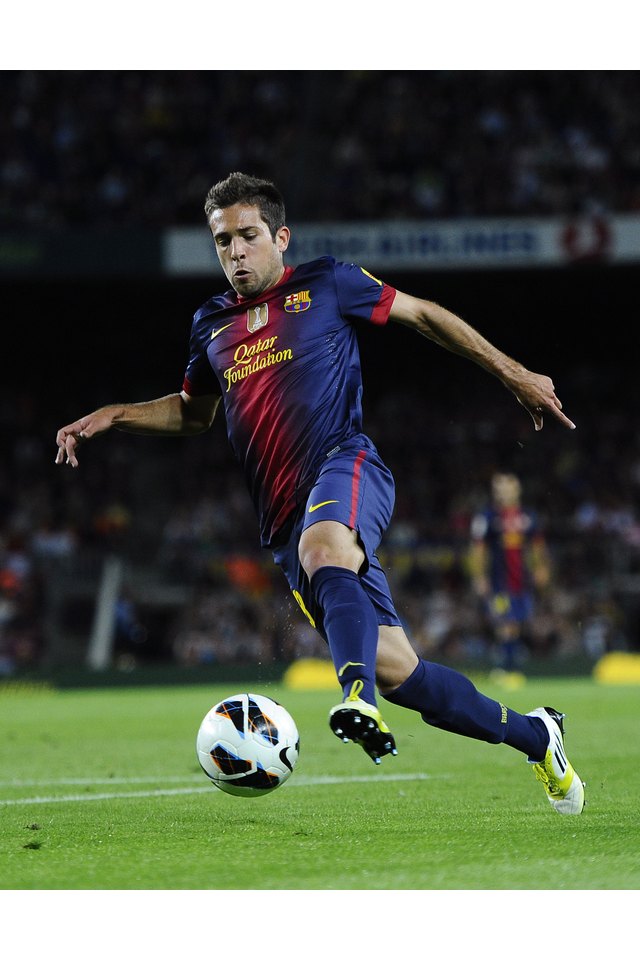Exercises to Be a Better Left Back in Soccer

The left fullback provides a crucial blend of defense and ball movement to your soccer team. If you’ve been tapped for this position, it means your coach likely sees you as an asset in terms of your fitness level, understanding of tactics and the strength of your nondominant foot. To improve at left fullback, you can study professional soccer in person or on TV -- left backs such as Barcelona’s Jordi Alba set the standard -- and work on specific exercises to improve your performance.
Understanding the Dominant Foot
The misconception that many right-footed players have is that their right foot is their "strong” foot, notes Wes Harvey, a coach of men, women and youth in Baltimore, Maryland. In fact, a right-footed player needs a strong left foot. “Ability to kick with the left foot requires strength and stability in the right ankle,” he notes. Thus left backs require a strong right plant foot or ankle to block opposing right strikers or midfielders from crossing in balls from the wing.
Strengthening the Plant Foot
To increase the strength of your right foot, ankle and lower leg, perform one-legged squats on each foot. You may be more familiar with regular squats, performed with your body weight, barbells, dumbbells or kettlebells. The one-legged squat differs in that you perform the same squatting motion, with one leg and then the other held in front of you, parallel to the ground. If you lack the initial fitness to do an unassisted one-legged squat, start with stairstep squats. Lower onto the second step of a staircase and bound back up. Work equally on your left and right legs to avoid imbalance.
Juggling on the Passing Foot
As a left back, you need an understanding of how your role differs from that of others on your team. “Most players are right-footed, especially in amateur ball where many players have never trained at all on their weak foot,” Harvey observes. “The strongest attack will come down the defending team’s left side, which is often the weak side unless the team has a natural lefty.” Thus left fullbacks not only need to train their right plant foot by one-legged squats, but also they need to control and pass the ball with their left, especially to their left midfielder. Juggling the ball with the left foot helps, Harvey advises. Gently tap the ball up repeatedly, going for just three or four consecutive taps and eventually trying for 20 and even more.
Conditioning and Skills Work
Left fullbacks need to be fit to provide overlapping runs to support the offense, as well as defensive runs against the other team’s strikers and wingers. Interval training such as alternating jog-sprints of short distances -- 5 to 30 yards -- helps provide the needed conditioning. Add agility training, such as skipping through a speed ladder, to help in neatly stripping the ball from opponents without fouling. And join the rest of the team to practice your headers -- you have the occasional chance to sneak in a goal by rushing in, usually unmarked, on corner kicks or even during the run of play.
References
- FC Barcelona: Jordi Alba
- Wes Harvey; Adult and Youth Soccer Coach; Baltimore, Maryland
- BodyBuilding.com: The Stair-Step Approach to One-Legged Squats
- Complete Conditioning for Soccer; Greg Gatz
- YouTube: Euro 2012 Final Spain v Italy Jordi Alba's goal 2-0
Writer Bio
An award-winning writer and editor, Rogue Parrish has worked at the Washington Post, the Baltimore Sun and at newspapers from England to Alaska. This world adventurer and travel book author, who graduates summa cum laude in journalism from the University of Maryland, specializes in travel and food -- as well as sports and fitness. She's also a property manager and writes on DIY projects.
